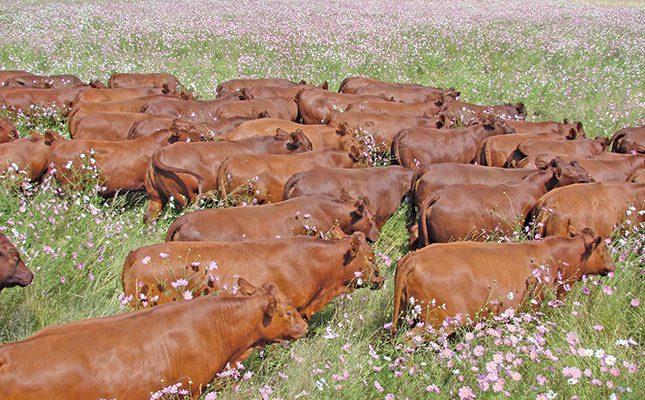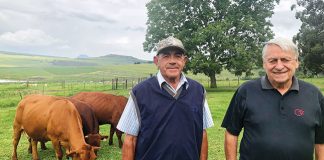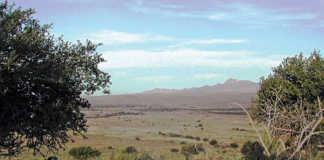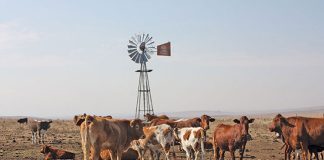
Animal welfare concerns the physical as well as psychological state of an animal. The way animals are raised and treated affects their welfare on many levels and also has an impact on sustainability, food security, and the economics of farming.
Stress is a major cause of disease in cattle and other livestock species, according to Leon Kruger, a lecturer at the University of the Free State’s Department of Animal, Wildlife and Grassland Sciences. Consequently, lessening stressors plays a cardinal role in the overall welfare of livestock.
It is imprudent, he stresses, for livestock producers to rely solely on vaccinations and veterinary medicines to prevent disease outbreaks in their herds and flocks. Infections like
Pasteurellosis and coccidiosis are examples of stress-related diseases. These two diseases pose serious problems, especially in feedlots. In addition to the clinical symptoms of disease, stressed animals’ growth rates tend to be poor, while production is also compromised, says Kruger.
According to the so-called Five Freedoms, an internationally accepted standard of care that affirms every living being’s right to humane treatment, animal welfare must ensure that the mental needs of livestock are met by providing conditions and treatment that don’t cause mental suffering.
The Five Freedoms
In 1965, Irish zoologist Francis Brambell’s research led him to recommend a basic set of standards for all animals under human control, regardless of species. Farm animals are included in the Five Freedoms, which are endorsed by the World Organisation for Animal Health. This includes freedom from hunger and thirst by having ready access to fresh water and feed to maintain health and vigour.
It also comprises freedom from discomfort by being provided with an appropriate environment, including shelter and a comfortable resting area, as well as freedom from pain, injury and disease.
The Five Freedoms also allow for animals to express normal behaviour by being provided with sufficient space, proper facilities, and company of each animal’s own kind. Freedom from fear and distress calls for conditions and treatment that avoid mental suffering.
“It’s of the utmost importance that the Five Freedoms are coupled with humane livestock management practices and acceptable methods of handling. I often liken dealing with livestock to taking care of children. It’s obvious that a child who is treated harshly and cruelly by its parents will suffer from much higher stress levels than a child who receives love and kindness. It’s exactly the same with livestock. The stress of animals that are chased, yelled at, or hit with whips or other objects will of course reach extremely high levels.”
Stress misunderstood
According to Kruger, the causes and effects of stress on livestock are not always well understood. This is because stress does not present with immediate symptoms or obvious signs.
“Stress is a topic that everybody thinks they understand, but to quote Hans Selye, a Hungarian psychologist, everybody knows what stress is and nobody knows what is,” he says.
Stress is not anxiety and has nothing to do with anxious or calm dispositions. There is, for instance, a perception that the Brahman cattle breed is highly anxious and sometimes difficult to manage, while the truth is that the breed is exceptionally calm, says Kruger.
Anxiety should therefore not be likened to stress. An animal or person suffering from stress does not show any outward symptoms, while sufferers of anxiety show very real and clear symptoms. Perceived anxiety or aggression in an animal has nothing to do with its breed, but depends on the management and treatment of the animal.
Kruger explains that homeostasis is the ability of human and animal bodies to be internally stable and to maintain that state. Stress is caused by the disruption of homeostasis. Numerous factors may interrupt homeostasis in livestock, even something as insignificant as moving a herd from one grazing camp to another. The movement means that the animals have to readjust themselves to new grazing conditions.
The introduction of new animals into a herd may also act as a stressor because of the disturbance this causes to the hierarchy of the group and the establishment of a new ranking order.
“Any external influence that makes it impossible for an animal to keep its homeostasis stable should be considered a stressor. The body reacts to stressors through hormone secretions by the hypothalamic-pituitary-adrenal axis,” says Kruger.
Under tense conditions, a stressor activates freeze, flight, fight or fright responses. This prompts the hypothalamus to release a corticotrophin hormone that stimulates the pituitary gland to release adrenocorticotropic hormones, which eventually trigger the release of glucocorticoid hormones (cortisol) by the adrenal cortex.
The effect of cortisol
Cortisol affects most of the homeostatic systems in the body, according to Kruger. It has a dramatic effect on the gluconeogenesis (production of glucose), inflammatory and immunological systems.
Through gluconeogenesis, additional glucose is released to the body to enable the animal to escape from a stressor. It is a proven fact, says Kruger, that cortisol not only raises physical strength, but influences animals’ and humans’ ability to think and act.
“Cortisol has a negative impact on the immune system as long as it remains in the circulatory system and will result in compromised immunity. Cortisol levels spike markedly during even the most routine livestock management procedures, such as dosing and vaccination. It usually takes about 90 minutes to return to normal levels. This is long enough for opportunistic bacteria such as Pasteurella [now known as Mannheimia haemolytica] to multiply radically,” says Kruger.
He explains that a single bacterium cell has the ability to divide into two every 20 minutes. This can result in billions of cells developing in 24 hours. By the time the immune system is fully functional again, the bacteria will have invaded the upper airways and been breathed into the lungs.
“The fact is that even when animals have been vaccinated or acquired natural immunity, they’ll be more susceptible to opportunistic micro-organism infections when cortisol levels are elevated,” says Kruger.
Correct handling of animals
For these reasons, animals should be habituated from an early age and get used to the presence of their handlers. It is preferable for handlers and stockmen to move between the animals daily.
In this way, the animals will eventually perceive their handler as a member of the herd. Animals accustomed to their handler will also have a small flight zone, which reduces stress levels markedly.
Kruger says: “I witnessed one of the most beautiful experiences of correct animal handling in Zululand. We were looking for indigenous Zulu sheep and found some in a rural village. The owner, an elderly woman, called on her grandson, who was at the primary school not far from her home, to go and look for the flock.
“As the sheep were grazing a short distance from the school, the boy whistled for them from the school veranda, and lo and behold, all the members of the flock rushed to their caller. That, in my opinion, was the purest form of how livestock should be managed. Calmly, warmly and without any commotion or fuss.”
Steering animals into handling facilities such as kraals and chutes can cause stress levels to rise very high. Such an operation calls for calm and assertive behaviour from the handlers, without shouting, whistling, the use of whips or any other action that could cause the animals to become frightened and end up with elevated cortisol levels.
“An animal’s skin, hair, tail and horns are not designed to be used as ‘tools’ to steer it by. Such action will invariably result in elevated stress levels. The best way to manage a sheep or a goat, for instance, is to place one hand under the chin and the other behind the head,” says Kruger.
According to him, the latest research has shown that a reward in the form of extra rations, for example, changes an animal’s negative perception of vaccination or any other procedure. A handful of chocolate maize or green feed after a procedure will go a long way towards changing this perception to a positive one.
Email Leon Kruger at [email protected].











